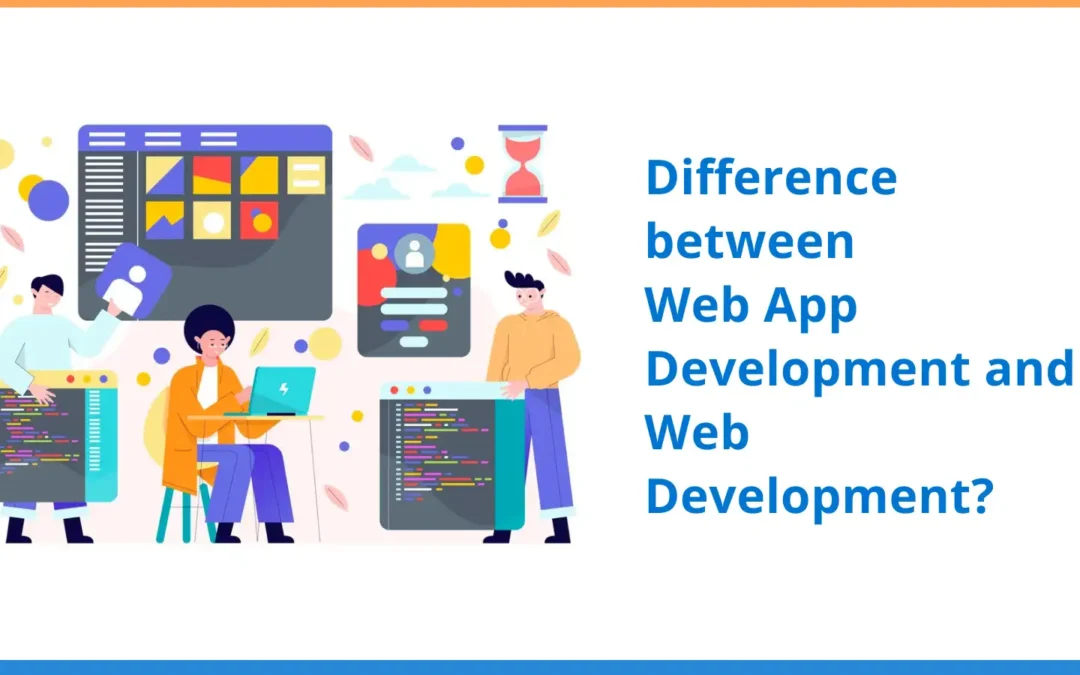In today’s digital age, a strong online presence is crucial for businesses of all sizes. Enterprise companies, startups, and seed-funded ventures alike are constantly navigating the ever-evolving landscape of web technologies. Often, terms like “web development” and “web application development” get thrown around interchangeably, but they represent distinct approaches to crafting digital experiences. Understanding this difference is vital for making informed decisions and choosing the web development vs. web app development path that aligns with your project’s goals.
Web Development: The Cornerstone of Your Online Identity

Web development refers to the creation and maintenance of websites. Think of websites as digital brochures or storefronts accessible through any web browser. They can be static, serving up basic information, or dynamic, offering interactive features and content updates. Here’s a breakdown of the core aspects of web development:
- Content Creation: Web developers craft the text, visuals, and overall structure of a website. This involves writing engaging copy, creating high-quality images and videos, and designing the layout using the fundamental building blocks of web development: HTML, CSS, and JavaScript.
- User Interface (UI) and User Experience (UX) Design: A website should not only be informative but also visually appealing and user-friendly. Web developers collaborate with UI/UX designers to ensure the website is aesthetically pleasing, easy to navigate, and provides a positive user experience.
- Website Functionality: While websites primarily focus on displaying information, some may require additional features. This could involve creating forms for user input, integrating e-commerce functionalities for online sales, or implementing a content management system (CMS) for easy content updates.
- Responsiveness and Optimization: In today’s mobile-first world, websites need to adapt to different screen sizes and devices (desktops, tablets, smartphones) to reach a wider audience. Web developers ensure websites are responsive and optimized for optimal performance across various platforms.
Common examples of web development include:

- A company website showcasing its products or services, with contact information and a blog section.
- A portfolio website for a freelancer, highlighting their skills and experience.
- A static landing page promoting an upcoming event or product launch.
Web App Development: Interactive Experiences Beyond the Static Page

Web applications (web apps) are interactive software programs accessible through a web browser. They offer a more dynamic and feature-rich experience compared to traditional websites. Here’s what sets web apps apart:
- Interactivity and User Engagement: Web apps go beyond displaying static content. They allow users to interact with data, perform actions, and receive real-time feedback. This interactivity is achieved through server-side scripting languages like Python, PHP, Java, or Node.js, working in conjunction with front-end technologies (HTML, CSS, JavaScript).
- Data Persistence and Functionality: Web apps can store and manage user data. This allows users to create accounts, save preferences, track progress, or even collaborate within the web app itself. Databases like MySQL or MongoDB are often used for data persistence.
- Offline Functionality (Optional): Some web apps can work to a limited extent even without an internet connection. This is achieved by storing data locally on the user’s device and synchronizing it with the server when an internet connection is available.
- Real-time Communication: Web apps can facilitate real-time communication between users or between users and the application. This can be achieved through features like chat functionalities, live updates, or multiplayer gaming elements.
Examples of web applications include:
- Gmail: A web-based email application for sending, receiving, and managing emails.
- Facebook: A social networking platform allowing users to connect, share content, and interact with each other.
- Google Maps: A web application for finding directions, exploring locations, and accessing geospatial information.
- Trello: A project management tool enabling users to organize tasks, collaborate with team members, and track progress.
The Blurring Lines: When Web Development and Web App Development Converge

The lines between web development and web app development can sometimes become hazy. Many websites incorporate elements of web app development. Here are some examples:
- Interactive Forms: Forms that validate user input, perform calculations, or provide real-time feedback require scripting beyond basic HTML.
- Content Management Systems (CMS): Systems like WordPress or Drupal combine website functionalities with some level of user interaction and data management.
- E-commerce Websites: Online stores involve complex functionalities like shopping carts, user accounts, and payment processing, blending aspects of both web development and web app development.
Choosing the Right Approach: Your Project in Focus

When deciding between web development and web app development, consider your project’s core objectives:
- Static Information Display: If your primary goal is to showcase information and provide a basic online presence, a website developed using HTML, CSS, and JavaScript might suffice.
- Interactive Features and User Engagement: If your project requires user interaction, data manipulation, or functionality beyond static content display, a web app is the way to go.
- Scalability and Future Needs: Consider future growth and potential additions to your online presence.
Additional Resources:

Keep up the great work! Thank you so much for sharing a great posts.
I absolutely loved the insights shared in this blog! While growing our business online, we’ve seen firsthand how important a well-designed website and a strong digital marketing strategy are. Whether it’s improving user experience or boosting visibility through SEO and social media, the right approach is what brings results. If you are also think to a visit a good web-development and digital marketing blogs so you can check my fresh content. We are very excited to share the results of our hard work in web development and digital marketing! Our website has been designed with a seamless user experience in mind, ensuring it looks great and functions flawlessly across all devices. With strong SEO optimization and targeted digital marketing strategies, we’ve successfully boosted our online visibility and connected with the right audience. We are proud of the impact our website and marketing efforts have had and look forward to continuing our growth. Check out our site to see how we bring innovation to life. This blog provides excellent tips and expert advice